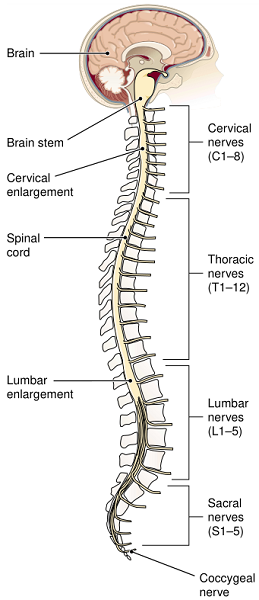The spinal cord extends from the medulla oblongata to between the first and second lumbar vertebrae. It has a central area of gray matter surrounded by white matter. The gray matter projects toward the back and the front as the dorsal and ventral horns. The white matter contains the ascending and descending tracts (fiber bundles) that carry impulses to and from the brain.
Thirty-one pairs of spinal nerves connect with the spinal cord (Fig. 1). These nerves are grouped in the segments of the cord as follows:
•Cervical: 8
•Thoracic: 12
•Lumbar: 5
•Sacral: 5
•Coccygeal: 1
Each nerve joins the cord by two roots. The dorsal, or posterior, root carries sensory impulses into the cord; the ventral, or anterior, root carries motor impulses away from the cord and out toward a muscle or gland.
A simple response that requires few neurons is a reflex. In a spinal reflex, impulses travel through the spinal cord only and do not reach the brain. An example of this type of response is the knee-jerk reflex used in physical examinations. Most neurologic responses, however, involve complex interactions among multiple neurons (interneurons) in the CNS.

FIGURE 1. Spinal cord from the side, showing the divisions of the spinal nerves.
责任编辑:admin
上一篇:YIN AND YANG---THE LAW OF NATURE
下一篇:医学文章阅读——Treatment by Differentiation of Syndromes

微信公众号搜索“译员”关注我们,每天为您推送翻译理论和技巧,外语学习及翻译招聘信息。